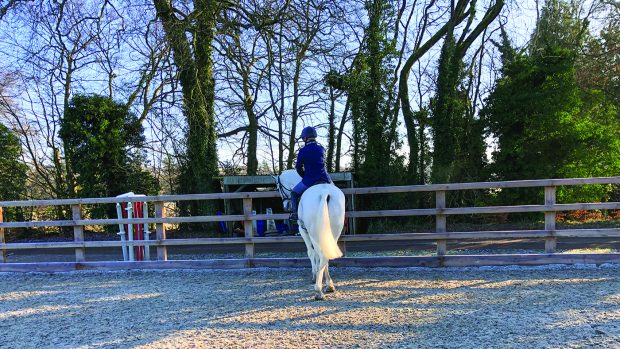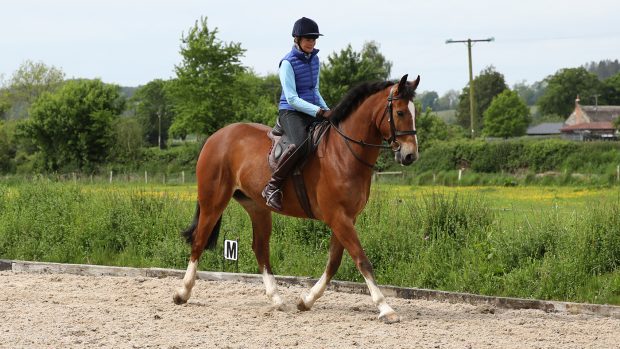There are many reasons to move from one discipline to another and, sadly, on occasion injury is the instigator. Louise Talbot had bought her eight-year-old horse Aatto for showjumping. However the unlucky son of Odemus R broke his leg on two occasions in 2012, once when kicked in the field and then by fracturing his splint bone in the stable.
With the help of trainer Simone Ward, Louise has turned to dressage and, at Brook Farm, Essex on 11 January the duo scored two plus-70% prelim wins.
“I changed over after the accidents,” Louise told H&H’s reporter, dressage editor Alice Collins. “But I don’t have a clue about dressage, Simone is showing us the way.”
We asked Simone for her tips on making the change from showjumping to dressage and a little bit more about herself and her training philosophies.
6 things to work on when making the transition from showjumping to dressage
1. Straightness
I see a lot of showjumpers who aren’t truly into the contact and rely on the inside rein to make turns especially in the jump off when they are going flat out. Consequently, the horse becomes unbalanced. To prevent this, I like to teach shoulder-in quite early to establish the hand to leg connection. I’ll ask a rider to ride shoulder-in on the track for 5m, then turn on to a diagonal line for 4-5 strides, making sure they have the outside contact. Then back to shoulder-in down the three-quarter line, followed by another diagonal line towards the centre line and then back down the centre line in shoulder-in to finish.
2. Engagement
At the lower levels, many showjumers are built quite heavily through the shoulder area and are weaker behind. Therefore I tend to use very quick direct transitions as well as transitions within the pace to strengthen the hind leg and develop engagement.
3. Suppleness
A lot of showjumping people are tight throught their bodies and use their legs rather than their whole body. I tend to spend the beginning and end of each session doing relaxing and stretching work, making sure the horse takes the rein forwards through lots of serpentines, spiralling in and out of circles and leg yield within all paces.
4. Find the right trainer
Make sure you choose a trainer that suits you. Make sure you ask any questions no matter how stupid they may sound and make sure you have a full understanding of the exercises plus the benefits. Ask yourself “what am I aiming for here”.
5. Learn from your mistakes
The more you make the more you learn from them. Question why have they happened, what is going wrong and adapt your aids accordingly.
6. Try and get a lesson on a schoolmaster
This will help you to understand how it should feel and what you are aiming for with your own horse.
What is your USP?
I try to make a training system that is easy for the combination of horse and rider to follow. I like to make sure the rider understands the mechanics and benefits of the exercises I set and try to avoid any grey areas in their training. Ultimately, the aim is to make sure that “black is black and white is white” and then there’s the best chance of getting it right. I have produced numerous horses from unbroken to FEI competition, several of these horses have been very tricky throughout their career so I have leant how to adapt my training to keep these “big personalities” on side.
What’s your pet hate?
Lack of discipline! For example, riders who think it’s ok to throw a horse into a transition or flying change just to change pace or lead, only then to reprimand the horse if he offers a sub-standard transition/change. How does the horse learn what is or isn’t acceptable doing that? Prepare properly and be both consistent and fair with your corrections.
Share with us your signature exercise
Variation within the lateral work. I like to change things around and keep the horse focused and supple. Throughout the whole session, including the warm up, I check I can change bend, degree of collection and angle within the various movements I’m riding (shoulder in, leg-yield, half pass, pirouette etc.,) to make sure he stays 100% on my aids.
What’s the best bit of advice you’ve been given and by whom?
Always do the opposite of what the horse wants to do. If he wants to run, slow down. If he wants to go deep, keep him up. If he wants to flex left, take him right… This was a piece of advice given to me by David Hunt about 15 years ago and it’s stayed with me, and I’ve used it, ever since.
If we were to ask your pupils, what would be the one thing they all say you continually shout?
“Speed control!” So often you see a horse running through the bridle while completely balancing on the rider’s hand, with the rider having little or no real control or using excessive leg aids to maintain the rhythm. I like to see riders taking the leg and rein aids away from the horse for a couple of strides to check that the horse remains in rhythm and carriage without the rider having to support him there.
If you’re interested in talking to Simone contact her via her website www.simonewarddressage.com




